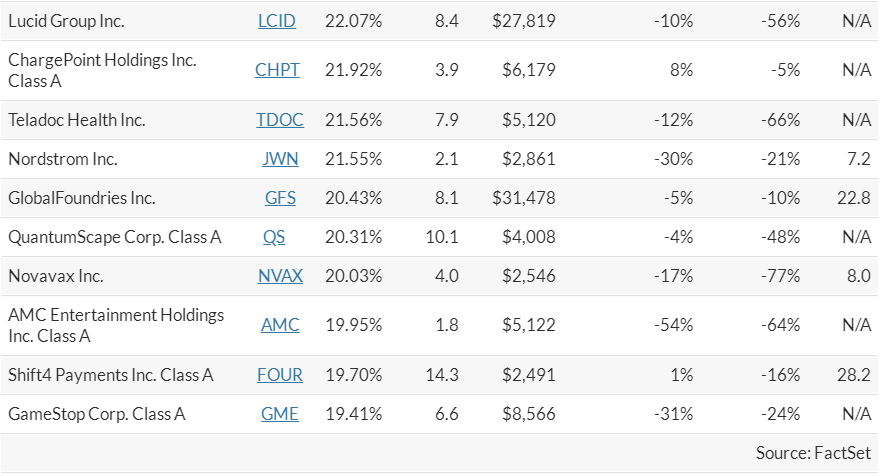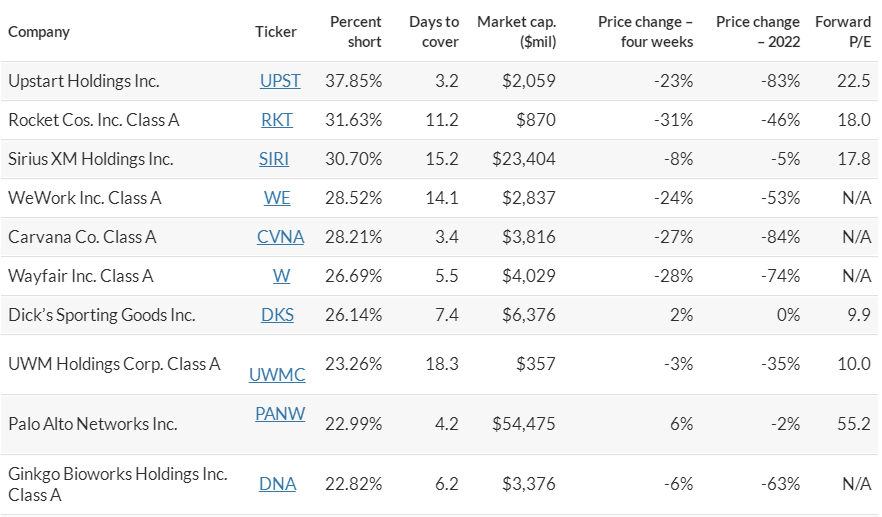Carvana and Lucid Motors are among the most heavily shorted stocks
Short selling is a trading technique that gets especially popular during bear markets in stocks.
Short selling -- or betting on a decline in prices -- can come to the fore if investors suspect a company is entering a difficult period, during a period of stress on financial markets, or when a group of traders acts to bid up the shares of companies that professional investors have bet against.
It is a very risky technique, as the losses are theoretically infinite, but it is also something every investor should at least understand.
Traditionally, short sellers have served a useful role, as they have pointed out problems with companies' business models, with their industries or even with the way they prepare financial statements. But shorting can also lead to furious trading activity that can burn investors quickly.
Apple Inc. $(AAPL)$ is now the most heavily shorted stock in terms of dollars committed to bets against the company's stock price. Tesla Inc. $(TSLA)$ had previously been in that position.
But in terms of short positions relative to the number of shares outstanding, Apple's is only 0.70% sold-short, while 2.32% of Tesla's share are shorted, according to the most recent data available from FactSet.
There are different ways of looking at short exposure, and a list of the most heavily shorted stocks among companies of the Russell 1000 Index , by percentage, is below.
Before digging into the short-selling data, let's review some terms:
- Short selling is when an investor borrows shares and immediately sells them, hoping to buy them back later at a lower price, return them to the lender and pocket the difference.
- Covering is when a person with a short position buys the shares to return them to the lender, to profit if the shares have gone down in price since they were shorted, or to limit losses if they went up after being shorted.
- A short squeeze is when a mass of investors looking to cover short positions start buying at the same time. The buying pushes the share price higher, making short investors accelerate their attempts to cover, which sends the shares spiraling higher in a frenzy. This is what happened earlier this year when a group of traders, who had organized themselves through the Reddit WallStreetBets channel, famously pushed the share prices of two troubled businesses sky-high: GameStop Corp. GME and AMC Entertainment Holdings Inc. AMC.
Short selling is best left to professional investors and traders because you cannot set an upper limit on how much you might lose if the shares rise in price after you short them -- you never know how high a stock price might go. If you buy a stock (take a "long" position), what you have risked is the amount of money you invested. You can lose it all if company goes bankrupt, for example.
But to short a stock you need a margin account, which means your broker extends credit if the stock goes up in price after you short it. At a certain point, if the stock continues to rise, your broker will demand collateral to protect its position. This means you will be more likely to be forced to cover the short trade and take a loss.
Borrowing shares to short them also costs money -- more about that below.
Most heavily shorted stocks
The Russell 1000 Index is made up of the 1,000 largest companies in the Russell 3000 Index , which is designed to represent 98% of publicly traded companies whose primary stock listings are in the U.S.
Here are the 20 companies in the Russell 1000 that are most heavily shorted on a percentage basis, according to the most recent data available from FactSet:

The company's rolling 12-month estimates for earnings and sales have been increasing and, on a calendar-year basis, the consensus expectation among analysts polled by FactSet is for its revenue to increase 28% in 2022.
From 2022 through 2024, analysts expect to see a compound annual growth rate of 21.6% for Palo Alto's sales. Maybe it is the high forward price-to-earnings ratio of 55.2 that has spooked investors. After all, the weighted forward P/E for the S&P 500 information technology sector has fallen to 20.5 from 28.1 at the end of 2021, according to FactSet. For the full S&P 500 , the forward P/E has declined to 16.7 from 21.4 at the end of last year.
The table includes "days to cover," which is the number of days it would take for short sellers to cover their positions, based on three-month average daily trading volumes. When considering which stocks might be candidates for short squeezes, Matthew Tuttle, CEO of Tuttle Capital Management in Greenwich, Conn., said in a previous interview that he begins with "a 10/10 rule." That stands for short interest of at least 10% and at least 10 days needed for short sellers to cover their positions.
Brad Lamensdorf, who co-manages the AdvisorShares Ranger Equity Bear ETF (HDGE), pointed to other costs that short sellers face. During an interview on Sept. 15, Lamensdorf said that an investor who wishes to short Apple's shares pays only a nominal "general collateral" fee to borrow the shares. In addition, the borrower of the shares will have to pay Apple's dividend to the investor who lends the shares. Apple's dividend yield is 0.59% -- "not much, but there is a carry," Lamensdorf said.
But he listed high annualized fees for borrowing shares of some of the heavily short stocks listed above:
- For AMC, it costs 16.73% to borrow the shares.
- For GME, the cost is lower: 7.88%.
- It costs about 2% to borrow shares of Carvana Co.CVNAto short.
- For Palo Alto and Dick’s Sporting Goods Inc.DKS,shares can be borrowed as “general collateral.”
The AdvisorShares Ranger Equity Bear ETF is designed to be a hedging tool, and has performed quite well this year, returning 12% through Sept. 14, while the S&P 500 has declined 16% (with dividends reinvested). You can read more about Lamensdorf's shorting strategy here.
Lamensdorf previously warned that a percentage of short-sales to total shares available for trading of "over 30% to 40% is outrageously high," as it makes short-squeezes more likely.

